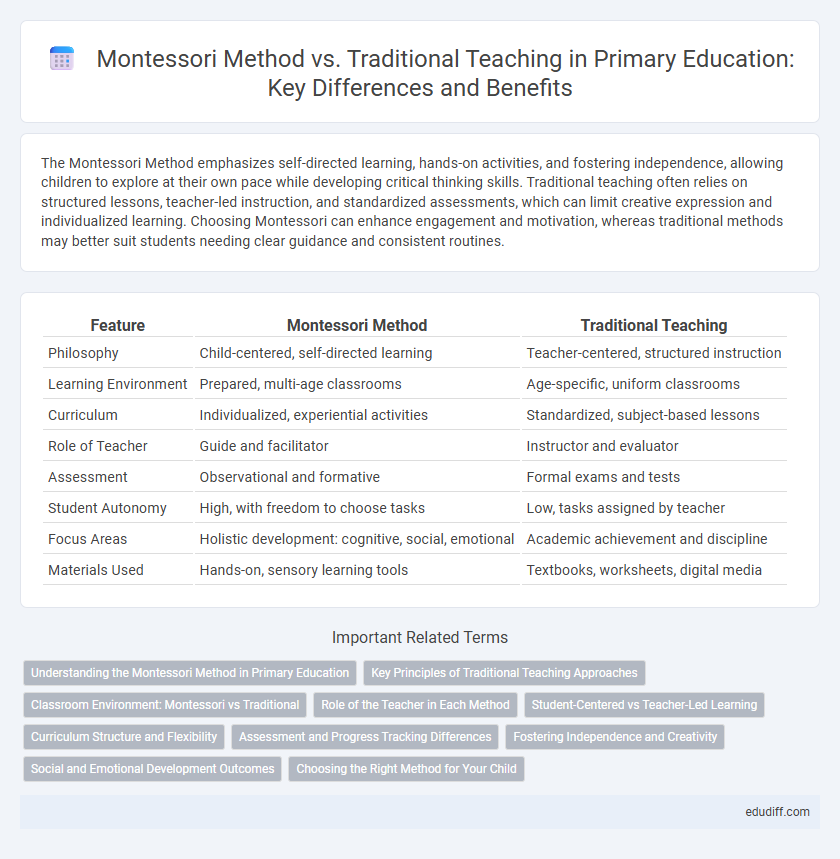The Montessori Method emphasizes self-directed learning, hands-on activities, and fostering independence, allowing children to explore at their own pace while developing critical thinking skills. Traditional teaching often relies on structured lessons, teacher-led instruction, and standardized assessments, which can limit creative expression and individualized learning. Choosing Montessori can enhance engagement and motivation, whereas traditional methods may better suit students needing clear guidance and consistent routines.
Table of Comparison
| Feature | Montessori Method | Traditional Teaching |
|---|---|---|
| Philosophy | Child-centered, self-directed learning | Teacher-centered, structured instruction |
| Learning Environment | Prepared, multi-age classrooms | Age-specific, uniform classrooms |
| Curriculum | Individualized, experiential activities | Standardized, subject-based lessons |
| Role of Teacher | Guide and facilitator | Instructor and evaluator |
| Assessment | Observational and formative | Formal exams and tests |
| Student Autonomy | High, with freedom to choose tasks | Low, tasks assigned by teacher |
| Focus Areas | Holistic development: cognitive, social, emotional | Academic achievement and discipline |
| Materials Used | Hands-on, sensory learning tools | Textbooks, worksheets, digital media |
Understanding the Montessori Method in Primary Education
The Montessori Method in primary education emphasizes hands-on learning and self-directed activity, fostering independence and critical thinking in young students. It utilizes specially designed materials to support sensory-based exploration and conceptual understanding, contrasting with traditional teaching's reliance on direct instruction and standardized curriculum. This child-centered approach adapts to individual learning paces, encouraging intrinsic motivation and holistic development in primary learners.
Key Principles of Traditional Teaching Approaches
Traditional teaching approaches emphasize structured curricula, teacher-led instruction, and standardized assessment methods. These methods prioritize memorization, repetition, and adherence to a fixed timetable, often focusing on subject-specific knowledge acquisition. Discipline and classroom management play a central role in maintaining an environment conducive to learning within traditional education settings.
Classroom Environment: Montessori vs Traditional
Montessori classrooms feature child-centered environments with hands-on learning materials arranged to promote independence and exploration, contrasting sharply with traditional classrooms that often rely on teacher-directed instruction and standardized seating. The Montessori approach emphasizes mixed-age groupings and movable furniture to encourage social interaction and self-paced learning, whereas traditional settings typically organize students by age with fixed desks aligned in rows. This design difference directly supports Montessori's goal of fostering intrinsic motivation and autonomy compared to traditional methods prioritizing uniformity and teacher control.
Role of the Teacher in Each Method
In the Montessori Method, the teacher acts as a guide and facilitator, creating an environment where children explore and learn independently, encouraging self-directed discovery and hands-on engagement. In traditional teaching, the teacher typically assumes a more authoritative role, directing lessons and controlling the flow of information to ensure students acquire specific knowledge and skills. The Montessori approach emphasizes observation and individualized support, while traditional classrooms prioritize structured instruction and standardized assessment.
Student-Centered vs Teacher-Led Learning
Montessori Method emphasizes a student-centered learning approach where children actively explore and learn at their own pace, fostering independence and intrinsic motivation. Traditional teaching relies on a teacher-led model with structured lessons, direct instruction, and a fixed curriculum designed to guide all students uniformly. Research shows that student-centered environments like Montessori enhance critical thinking and creativity, while teacher-led classrooms prioritize accountability and standardized assessment outcomes.
Curriculum Structure and Flexibility
The Montessori method features a student-centered curriculum emphasizing hands-on learning and self-paced progression, allowing children to explore subjects in a natural sequence. Traditional teaching follows a structured, teacher-led curriculum with fixed schedules and uniform assessment criteria, focusing on standardized content delivery. Montessori's flexible approach fosters individualized learning paths, while traditional methods prioritize consistency and uniformity across the classroom.
Assessment and Progress Tracking Differences
Montessori Method emphasizes individualized assessment through observation and portfolio work, avoiding standardized tests to track student progress. Traditional teaching relies heavily on formal evaluations and standardized testing to measure academic achievement and development. Progress tracking in Montessori focuses on skills mastery and personal growth, while traditional methods prioritize grade-based performance metrics.
Fostering Independence and Creativity
Montessori Method prioritizes fostering independence and creativity by allowing children to choose activities that match their interests and pace, stimulating intrinsic motivation and problem-solving skills. Traditional teaching often emphasizes structured lessons and teacher-led instructions, which can limit opportunities for self-directed learning and creative exploration. Research indicates that Montessori environments promote higher levels of executive function and creative thinking in primary-aged children compared to traditional classroom settings.
Social and Emotional Development Outcomes
Montessori Method fosters social and emotional development by encouraging collaborative play, independence, and self-regulation, which enhances children's empathy and confidence. Traditional teaching often relies on structured group activities and teacher-led interactions, promoting conformity and social skills within a controlled environment. Research indicates Montessori students demonstrate higher emotional resilience and peer cooperation compared to their traditionally taught peers.
Choosing the Right Method for Your Child
Choosing the right educational method for your child depends on their individual learning style and developmental needs, with the Montessori Method emphasizing hands-on, self-directed learning and fostering independence. In contrast, traditional teaching offers structured, teacher-led instruction focused on standardized curriculum and assessment. Evaluating your child's personality, adaptability, and learning preferences helps determine whether a Montessori classroom or traditional setting will best support their academic and social growth.
Montessori Method vs Traditional Teaching Infographic

 edudiff.com
edudiff.com